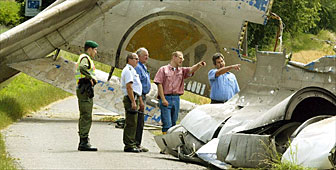Swiss air traffic systems found wanting

Switzerland's air traffic controllers were told a week before a fatal mid-air collision that their radar system was not up to European standards.
A report, released last week, called for improvements to bring Swiss radar into line with standards set by Eurocontrol, the European agency in charge of tracking aircraft in flight.
The report, by the Swiss Aircraft Accident Investigation Bureau, is adding to the pressure on the air traffic control body, Skyguide, which has admitted its systems were not fully functional during Monday night’s mid-air collision of two jets which killed 71 people – mostly children – near the Swiss-German border.
The crash took place while a collision warning system at Zurich airport was out of action for maintenance checks. At the time, only one air traffic controller was on duty.
Last week’s report said one of the shortcomings of the Swiss system was that an aircraft’s location on Skyguide’s screens is only updated every 12 seconds instead of the recommended eight.
On Thursday, the Swiss and German authorities confirmed that they had launched separate investigations into the circumstances surrounding the crash.
Both are trying to determine whether mistakes made by Skyguide were responsible for the collision.
Christoph Naef of the Zurich prosecutor’s office, which is handling the Swiss investigation, said the proceedings were launched on suspicion of manslaughter and disruption of air traffic.
“Severe” problems
One of the bureau’s investigators, Jean Overney, told Swiss television that the radar problems “were severe enough that we told them to improve it so that the reduced vertical separation minimums that have been introduced can be [implemented] with sufficient safety”.
New rules that took effect in Europe this year reduced the vertical distance that aircraft must maintain from each other to 300 metres from 2,000.
However, Carlo Bernasconi, head of operations for Skyguide, told Swiss television that the report’s recommendations had no impact on Monday’s crash, when a Boeing 757 cargo jet collided with a Russian passenger aircraft in Swiss controlled airspace.
“The shortcomings had no bearing on the accident, with the only possible exception of the screen update standard,” he said. “An eight second delay might have allowed the controller to warn the Russian jet to move four seconds sooner.”
Warning was tight
On Thursday, German investigators said the pilot of the Russian aircraft was first warned to descend by Swiss air traffic control only 44 seconds before the collision.
Peter Schlegel, head of Germany’s federal accident air investigation office, said investigators had reduced the figure from an estimated 60 seconds after a thorough verification of radio records.
He added that the pilot should have been given at least “one and a half minutes before the crossing point”.
Swiss air traffic controllers admit that the warning was tight, but insist that it was within acceptable limits.
They also say it took the Russian pilot 25 seconds to react, by which time the collision warning system on the other aircraft had warned its pilot to descend. Both jets were therefore diving to avoid a crash, when they collided in mid-air.
Controllers were warned
On Thursday, Russia’s RIA news agency reported that the Russian airliner alerted Swiss air controllers that it was on a collision course with the other jet 90 seconds before they crashed.
Quoting unidentified Russian investigators at the crash site in Germany, the agency said the crew had told Swiss controllers that the Russian Tupelov-154’s onboard collision warning system had registered that the plane was on the same trajectory as the DHL Boeing 757 cargo plane.
There was no confirmation of the report from other investigators.
Parents’ visit
The parents of the 45 Russian children killed in the collision are in Germany visiting the crash site and helping with the identification of the victims.
A special flight brought the families from Ufa, an industrial city in Russia’s eastern Bashkortostan region, where most of the children lived.
The parents were asked by crash investigators to bring their children’s dental records or other items to facilitate DNA identification, but police said they had doubts whether all the dead could be identified.
German officials said counselors would be on the site to help the families and that they would not have to look at the remains of their loved ones.
The collision scattered bodies and debris over an area of 30 kilometres and 1,200 workers have been taking part in the salvage operation since Monday night.
There is speculation that the families might bring legal action against Skyguide. A spokesman said on Thursday that the company, which is almost wholly owned by the Swiss government, had insurance cover of SFr500 million (€341 million) for such claims.
swissinfo with agencies

In compliance with the JTI standards
More: SWI swissinfo.ch certified by the Journalism Trust Initiative
You can find an overview of ongoing debates with our journalists here. Please join us!
If you want to start a conversation about a topic raised in this article or want to report factual errors, email us at english@swissinfo.ch.